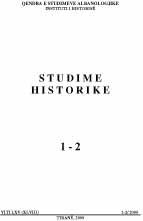Kalaja e Koxhaxhikut (Dibër)
Koxhaxhik’s Castle (Dibër)
Author(s): Adem BunguriSubject(s): History
Published by: Qendra e Studimeve Albanologjike
Keywords: Koxhaxhik’s Castle (Dibër); Albania; Albanian History;
Summary/Abstract: Koxhaxhik’s castle lies at Zhupa area, between Dibra and Struga, in the western parts of FYROM. It was placed at a very rocking crest and in a very strategic favourable position, easy controlling the road through the Drini i Zi valley. This is a very important road, which join the two most important transbalkanic roman vias: the ancient via Egnatia on the skuth (Ohrid basin) and the Lissus-Naissus on the north(Kukesi basin). Being the northern branch of via Egnatia, the Drini i Zi road was the very strategic corridor through the prehistoric times to nowdays. At Koxhaxhik’s castle there are some traces of its inhabitation since the late bronze age and early iron age, as well as the late antiquity period and the mediaval ones. There are some parts of its late antiquity period and medieval ones fortification system, on the upper platform of its even rocking surface. Its even surface has a polygonal plan with perimeter 145m, 58 m long and 34 m wide, and a surface nearly 1600 m2.The walls follow the lines(contours) of the crest, except the southern side, including within the defensed surface two narrow tarraces with good dwelling conditions. The wall used the defense abilities of the rocking crest, somewhere including in its structure the natural rocks, or interrupting itself where its slopes are rocky or very steep ones. The nowdays wall’s remains consist by 7 tracts of the surrounding walls, respectively 2 m, 3.5 m, 6 m, 2.10m, 9 m, 6 m and 22 m long and its seeing perimeter 50.60 m. (fig. 6. The outline plan of Koxhaxhik’s castle). The wall of the late antiquity period is actually the earliest fortification of Koxhaxhik’s castle. We could see it in the outer line wall of its tower. It had been builded with river and natural stones related with limestones mortar, by opus incertum technique. The castle had nearly been refortificated in medieval period, fulfilling the damaged parts and rebuilding the new ones lines of them. To the medieval period belong all the remains tracts, named A-G, 50.60 m long in generally, including the outer second wall of the its tower. Their height moves from 1.00 m to 2.5- 3m, whereas their width moves from 1.40 to 1.70m. A similar width of surrounding walls have already been seen in some other medieval castles of Albania, such as the castle of Kruja, Shurdhahu(near Scodra), Daula(Kurbin), Stelushi(Diber-Mat), Guri i Bardhë(Petralba) etc. In the chronological viewpoint, the medieval fortification of Koxhaxhik’s castle belong to the XIV-XV centuries A.D. To this period conform the technique of building of the surrounding walls, their narrow width, the tecniques features of the mortar determinated by the limestones, the using of the iron building scaffold etc. To the medieval preosman period of the XIV-XV centuries A.D. belong nearly all the the fragments of vessels founded on this castle and its varosh.
Journal: Studime Historike
- Issue Year: 2009
- Issue No: 01-02
- Page Range: 027-056
- Page Count: 30
- Language: Albanian
- Content File-PDF

